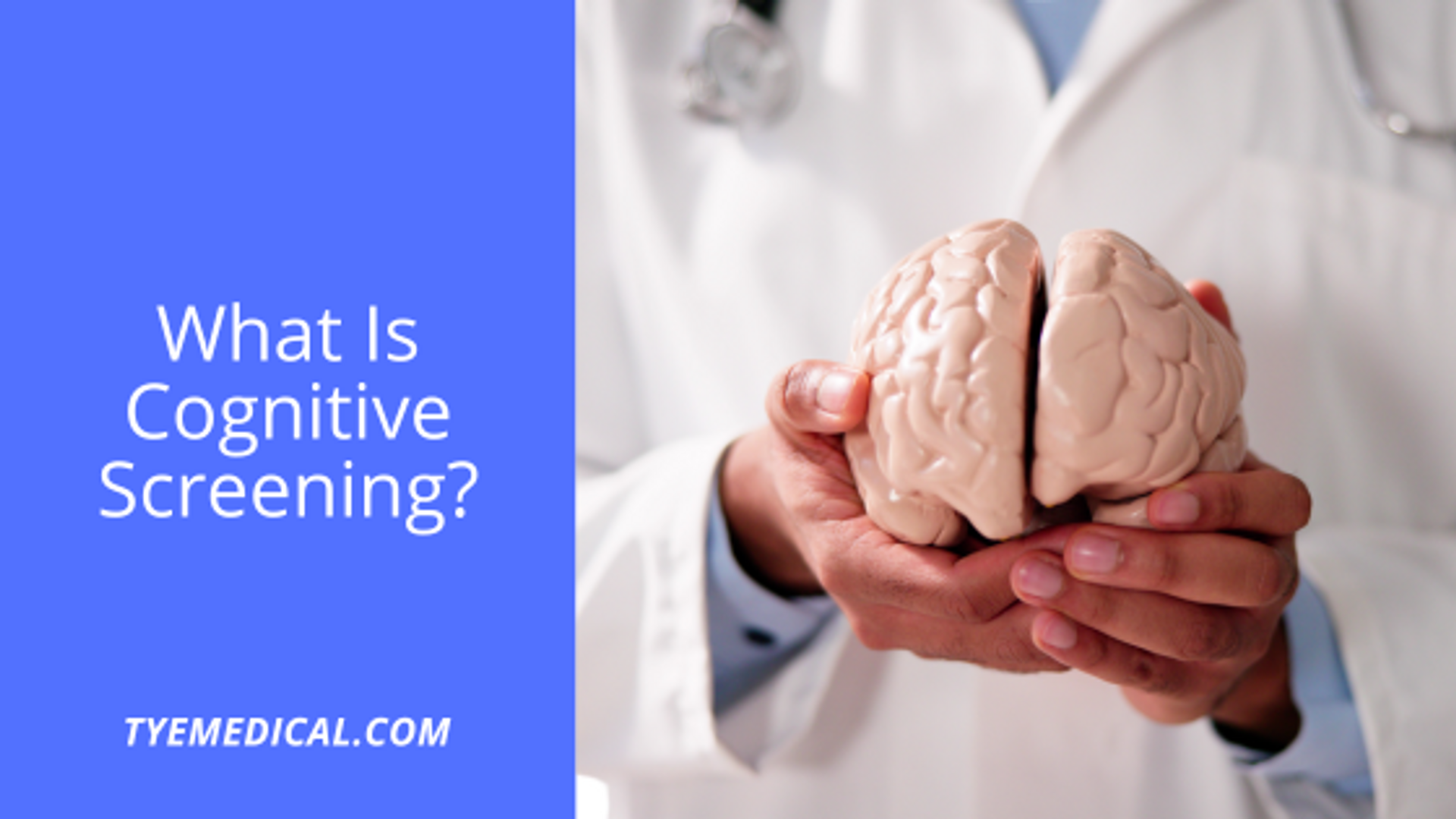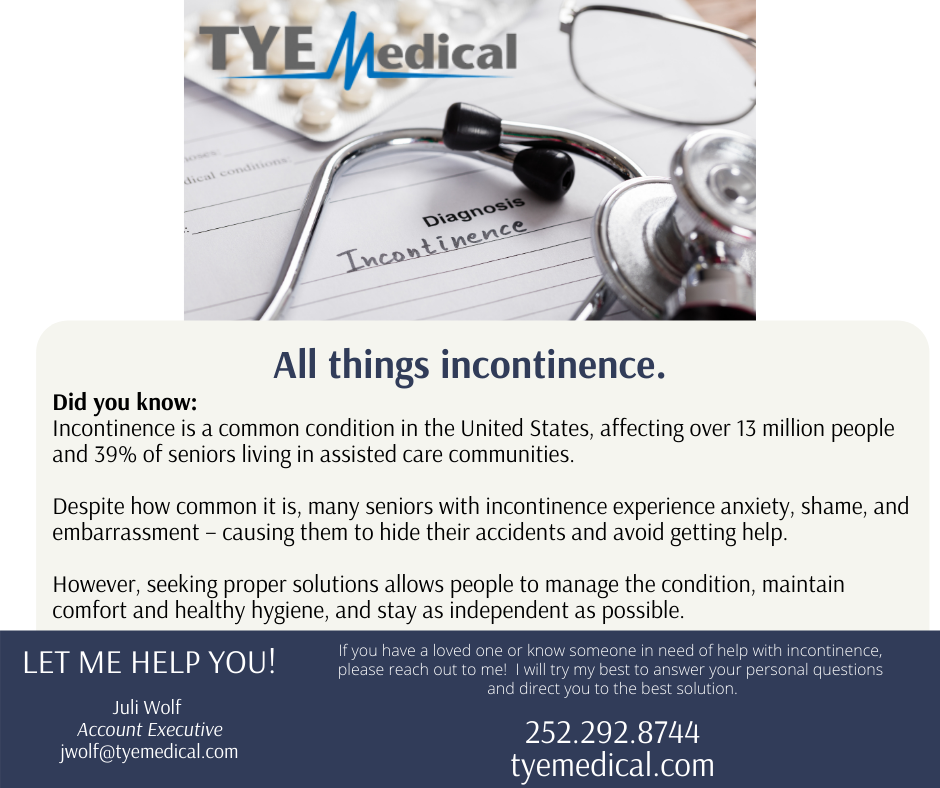What Can Cognitive Screening Show (and When Should You Get It?
Tye Medical Incontinence Products
For more information about the author, click to view their website: Tye Medical
Jun 17, 2024
Florida - Sarasota, Bradenton & Charlotte Counties
Email US
Click to Email UsGrowing older comes with outward signs of aging that you might find difficult to accept. Spotty skin, graying hair, and an achy body aren’t exactly perks of aging. But changes are unavoidable, even when it comes to your brain.
Did you realize that your brain shrinks with age? This process begins as early as your 30s and 40s. This shrinkage also affects your learning and memory center, known as the hippocampus. Age-related decline also decreases blood flow to your brain while increasing inflammation. Communication between nerve cells (neurons) becomes less effective as you age.
While you might not look or feel as well as you once did, your brain is also experiencing changes. While this might all seem bleak–it’s just a normal part of aging most of the time. Age-related cognitive decline happens gradually for most people.
Sometimes neurodegenerative changes aren’t aren’t so normal in older adults. Cognitive screens at the right time can help you catch declines early and even address underlying causes to slow or reverse these negative changes.
What Is Mild Cognitive Impairment (MCI)?
MCI is an early stage of declining cognitive (thinking) function. It usually involves some degree of memory or language loss that is greater than expected at someone's age or health. When you have MCI, you can function in daily life without help, but symptoms can progress until they’re no longer mild. You may eventually require assistance with daily tasks.
Although MCI’s exact cause isn’t known, it’s apparent that certain processes in the brain trigger toxic clumps of proteins to collect, allowing other toxic proteins to damage and kill neurons. For some, this decline is connected to the early stages of dementia or Alzheimer’s, which are considered more advanced cognitive impairment that includes functional impairment (or loss of abilities).
Of course, age increases your risk of MCI but so does a genetic predisposition to Alzheimer’s. Other medical conditions like high blood pressure, diabetes, and depression are also MCI risk factors.
The Benefits of Cognitive Screening
Early detection can be key to stopping or reversing neurodegeneration. Cognitive screening can help you catch negative changes before they cause serious problems. Often, abnormal cognitive decline has underlying causes that can be addressed, such as medication side effects or nutritional deficiencies. And both lifestyle changes and new medications can slow the progression of dementia if detected in the early stages.
What Is Cognitive Screening?
Cognitive screening includes testing assesses different aspects of your mental functions with the purpose of detecting any problems with thinking, memory, problem solving, language, and other cognitive abilities.
This type of screening is usually brief, like a questionnaire. But it’s not used to diagnose a condition and is instead a means of determining if you need further evaluation to make a diagnosis. It's evaluating whether you’re experiencing difficulty with mental functions before you or those close to you notice there is a problem. Think of it as a pre-assessment or preliminary step.
When Is the Best Time for Cognitive Screening
Best rule of thumb: don’t wait. Once you’re noticing memory problems that are disrupting your life, you’re already past the screening stage. At that point, it’s time for diagnostic testing to determine the specific cause and treatment. You should get a screening to make you aware of what is not yet noticeable, something that might be lurking but correctable, something to be addressed to prevent further decline.
You might wonder when to get your first assessment. It’s reasonable and worthwhile to get one at age 65 when you enroll in Medicare. It should be included in your annual wellness checkup, but be sure to confirm this or ask your doctor. This is especially if you haven’t had any symptoms prior to age 65. But if you’re in tune with your body and feel like something is off, even without obvious symptoms, it’s reasonable to get screened prior to 65.
Your primary care physician can perform a cognitive screening if there is no reason why you should see a specialist.
What Is the Cognitive Screening Process?
It’s typically about 10 minutes or less and covers three assessments:
- Montreal Cognitive Assessment
- Mini-Mental State Exam
- Saint Louis University Mental State Exam
You can expect to be asked brief questions without any prior preparation. For example, during the Mini-Mental State Exam, you will be given three words and are asked to repeat them after a few minutes. You will also need to draw a circular clock and position the hands at a specified time. Other tests assess your “orientation” to ensure you know the date, your name, and where you are. These tests include questions to evaluate your:
- Attention span
- Short-term learning abilities
- Both short- and long-term memory
- Concentration
- Language abilities
These screenings are designed to assess different areas of brain function.
Can You Do Online Screenings at Home?
The most reputable, do-it-yourself, online cognitive screening is the Self-Administered Gerocognitive Exam (SAGE). It’s a short, written exam that can be taken at home and doesn’t require a trained professional to administer. It takes about 10-15 minutes to complete. It measures a range of abilities like reasoning, memory, language, and orientation.
However, you don’t get immediate results, because you don’t determine the results yourself. There is no answer key or way to score it on your own. It’s designed to be completed and given to your primary care physician who will score it and interpret the results. It will be up to your doctor to determine if you need further examination.
What Happens After Cognitive Testing?
For many people, cognitive testing yields positive results and requires no further evaluation. But you may need further testing if the screening indicates a degree of cognitive impairment. If this is you, don’t panic. Not everyone with mild cognitive impairment (MCI) has or will develop dementia.
According to the Mayo clinic, only about 10-15% of people with MCI later develop dementia. Many underlying causes can be addressed, like thyroid problems, sleep issues, and vitamin deficiencies like B12. When you treat these causes, your brain impairment is likely to improve.
Sometimes a brain scan is necessary to determine if you have inflammation, tumors, or small strokes. It can also detect infection and structural problems in the brain.
What Does an MCI Diagnosis Mean?
If you get an MCI diagnosis, you can think of it as the stage between normal cognitive decline (due to aging) and more concerning decline like dementia. But remember, MCI doesn’t mean that dementia is inevitable. As mentioned previously, most people with MCI don’t move into the more serious state of cognitive decline, known as dementia.
But it’s not easy to distinguish between MCI and the typical effects of aging on the brain. It’s not uncommon for doctors to completely miss an MCI diagnosis. While having MCI is a risk factor for dementia or Alzheimer’s disease, these conditions aren’t inevitable. It’s possible for your MCI symptoms to remain the same or improve.
Talk to your doctor about lifestyle changes that can help slow declining mental function.
Recommended Lifestyle Changes for Improved Brain Health
Boosting brain health means taking steps that improve your health in general. In fact, you’ve probably heard most of these recommendations before.
- Quality and sufficient sleep
- Exercise
- Nutritious diet
- Socialization
This is not headline news, but adopting these healthy habits can have a notable impact on your cognitive health. For instance, sleep is crucial, because during this time your body removes toxins from your brain, which is key to preventing dementia and Alzheimer’s.
Concerning diet, experts recommend a Mediterranean-style diet for brain function. This would include diets like the original Mediterranean Diet, the MIND Diet, and the Mediterranean-DASH Intervention for Neurodegenerative Delay). These eating plans involve less red meat and more produce. People who eat according to these plans have fewer signs of Alzheimer’s according to a study sponsored by the National Institute on Aging.
Despite the importance of all these lifestyle factors, the addition of exercise has the strongest evidence for improving various cognitive functions. This is according to a review of 65 research studies.
What If You Need Medication for MCI?
Sometimes, it takes more than lifestyle changes to effectively battle MCI and stave off early on-set Alzheimer’s disease. Medications can help slow both MCI and Alzheimer’s, but this is a decision for you to make with your doctor.
Medication to consider include:
- aducanumab (Aduhelm)
- lecanemab (Leqembi)
- donanemab (likely to be approved soon)
You and your doctor can weigh the benefits of medication against the side effects.
Cognitive Screening Is a Tool Worth Using
When you turn 65 and are enrolled in Medicare you can take advantage of cognitive screening during your annual wellness visit. The cost should be included in the annual exam. But not all seniors get their annual physical and miss this “free” cognitive screening. And some who do get an annual physical through Medicare claim they never got the screening. Be sure to ask about cognitive screening when you schedule your annual physical with your Medicare plan.
You can be proactive in preventing mild cognitive impairment and the onset of dementia but there are no guarantees. Cognitive conditions like dementia and Alzheimer’s have a genetic component that you cannot change. But you may be able to delay the onset with good lifestyle habits like regular exercise, good sleep, socialization, and a Mediterranean-style diet.
TYE Medical offers premium incontinence products in a variety of sizes and absorbency levels. Shop our online store for free and discreet shipping on all orders!
- To view the original version of this article visit tyemedical.com/blog/what-can-cognitive-screening-show-and-when-should-you-get-it/
- Seniors Blue Book was not involved in the creation of this content.
Other Articles You May Like
Think Fast! Best Brain Games and Apps for Older Adults
Even the healthiest individuals can be quick to complain theyre not thinking as fast as they once did. Words and names may not come to mind as readily. And learning new tasks could become more of a challenge. Perhaps youve witnessed this in an aging loved one. Or maybe youre seeing it in yourself.Common causes or problems with memory or thinking abilities may include medication side-effects, problems with hormones, infections, or damage to brain neurons.While research findings remain inconclusive, more scientists are studying the benefits of brain fitness games for older adults including those with dementia.Downloadable AppsThere are a lot of apps and other tools on the market that claim to help with memory training. From an app store, you can download apps of their favorite game shows, such as Jeopardy, Wheel of Fortune and Family Feud.Need More? 5 Free Brain Training Apps for Older AdultsThese brain games might be great for your loved one to do alone or with you or other family members. Check out additional ideas at Very Well Mind.1. Luminosity: Over three billion games have been played by more than 85 million peopleCreated by more than 100 researchers from around the globe and launched in 2007, this was one of the first apps in the brain-training empire. They help older adults by providing exercises devised to improve five areas of cognitive function: problem-solving, memory, attention, speed and flexibility.2. Peak: Short, intense workouts plus a virtual coach to track your progressIs your older adult looking for something quick? Why not try mini games, which push you hard with short, intense workouts. These mental gymnastics help boost memory, problem-solving, concentration, language and more. Utilizing research from scientists from prestigious universities like Cambridge and Yale, Peak was rated by Google in 2016 as one of the best Android apps.3. Elevate: One of iPhone's best apps in past decadeElevate can set older adults up with daily entertaining-yet-challenging games to help build communication and analytical abilities. Their mini games are geared toward strengthening focus, memory, reading comprehension and other cognitive skills.4. Cognifit Brain Fitness: Brain games and moreWhat stands out in this app designed by neuroscientists are its specific programs to stimulate or rehabilitate brain function in people with conditions like dementia, Alzheimers, Parkinsons, multiple sclerosis, brain injuries and more. If you or your senior thrive on social interaction (which also can help keep your brain healthy), you can challenge friends and see how you rank in real-time monitoring.5. Braingle: Free website that provides more than 15,000 puzzles, games and brain teasersBraingle is a place to solve puzzles, brush up on your trivia, play games and give your brain a workout. Braingle has a wide variety of offerings, including optical illusions, codes and ciphers, and trivia quizzes. You can even create your own puzzles to give your brain a super workout.While technology may be beneficial, so too is one-on-one contact with others and the personal relationships that result. Reach out to Home Instead to learn more about how trained Care Professionals provide companionship to older adults.
6 Brain Exercises You Should Start Your Day With To Keep Your Cognitive Health In Check
Starting your day with brain exercises is one of the most effective ways to maintain cognitive health, improve memory, and enhance mental agility. Just like physical exercise strengthens the body, mental exercises help keep the brain sharp, reducing the risk of cognitive decline and boosting overall productivity. By engaging in simple yet effective activities each morning, you can stimulate neural connections, improve focus, and set a positive tone for the rest of the day. One of the most powerful ways to enhance cognitive function is through mindful meditation. Practicing mindfulness for just a few minutes each morning helps reduce stress, improve concentration, and enhance memory retention. It allows the brain to enter a relaxed yet focused state, promoting better emotional regulation and decision-making skills. Research has shown that regular meditation can even lead to long-term changes in brain structure, increasing grey matter density in areas responsible for learning and memory. Engaging in mentally stimulating activities such as puzzles, chess, or brain-training apps is another effective way to activate different areas of the brain. These activities improve problem-solving skills, encourage critical thinking, and enhance memory. Dedicating just 10 to 15 minutes each morning to solving crossword puzzles or playing logic-based games can significantly strengthen cognitive flexibility and mental sharpness. Physical exercise also plays a crucial role in maintaining brain health. Activities like stretching, yoga, or even a brisk morning walk increase blood flow to the brain, delivering oxygen and essential nutrients that support cognitive function. Exercise has been linked to the production of brain-derived neurotrophic factor (BDNF), a protein that promotes the growth of new neurons and enhances memory. Movements that require coordination, such as dancing, are particularly effective in improving brain plasticity and boosting cognitive resilience. Writing is another powerful brain-boosting activity that enhances memory recall, sharpens language skills, and improves problem-solving abilities. Journaling or expressive writing in the morning allows you to organize your thoughts, set goals, and express emotions, which can reduce stress and enhance mental clarity. Research suggests that writing by hand activates areas of the brain associated with learning and comprehension, making it an excellent exercise for cognitive health. Challenging the brain with new information every morning also helps stimulate neural connections and strengthen mental agility. Whether its reading an article, learning a new word, practicing a foreign language, or even picking up a musical instrument, acquiring new knowledge supports long-term brain health. Studies have shown that lifelong learning reduces the risk of age-related cognitive decline and improves problem-solving skills. Another effective mental exercise is visualization, which involves mentally picturing a task, goal, or scene to enhance cognitive function. Mental mappingsuch as visualizing your daily route, the layout of your home, or a specific environment in detailcan strengthen spatial awareness and memory. This practice also enhances problem-solving abilities and fosters creativity, making it a valuable technique for boosting cognitive performance. Incorporating these brain exercises into your morning routine can have long-lasting benefits for cognitive health. The brain is most receptive to stimulation in the morning when it is well-rested and free from distractions. By prioritizing mental fitness through activities like meditation, puzzles, physical exercise, writing, learning, and visualization, you can boost productivity, enhance focus, and promote overall well-being. Consistently practicing these habits trains the brain to remain agile, resilient, and efficient, helping you stay mentally sharp throughout life.
How can you lower your dementia risk?
At Grey Matters Health, we're always watching for news articles to help inform and encourage you in your brain health journey. The recent article "Doctors Share The 14 Things You Can Do To Lower Dementia Risk Right Now" from Womens Health provides expert-backed strategies to help reduce the risk of developing dementia. Dementia, including Alzheimers, affects millions globally, but proactive lifestyle changes can significantly lower the likelihood of cognitive decline.Key recommendations include maintaining a healthy weight, managing conditions like diabetes and high blood pressure, and quitting smoking. Cardiovascular health is vital, as a healthy heart promotes better brain function. Incorporating physical activity, such as walking or strength training, and eating a balanced diet, like the Mediterranean or DASH diet, supports brain health.Mental stimulation is equally important. Engage in activities that challenge your mind, like puzzles, reading, or learning new skills. Social connections also play a crucial role; maintaining an active social life helps combat loneliness and improves cognitive resilience. Additionally, quality sleep is emphasized, as inadequate rest can lead to harmful brain changes over time.Limiting alcohol consumption and avoiding exposure to air pollution are other essential steps. The article underscores that while no single change guarantees protection, adopting multiple healthy habits can dramatically reduce your dementia risk and enhance overall well-being. By starting these practices now, you can protect your brain for the long term.You can read the entire article at www.womenshealthmag.com/health/a63227792/lower-dementia-risk-doctors/.For more about protecting your future independence and longevity, visit www.GreyHealthMatters.org.
Local Services By This Author
Tye Medical
Assistive Devices , , Florida, 00000It takes collaboration of great minds, a great passion and great brand to successfully foster our global mission to empower the over 33 million Americans suffering from urinary incontinence and the many challenges it can bring to make a smart product choice as their incontinence solution. We are honored to showcase our product and to continuously raise the standards of our customer experience, improve the quality of their life andEmpower their Health.Inspiring a healthier life for everyone, everyday. Contact Julie Wolf today your local Tye Medical Professional in Florida directly at252-292-8744
TYE Medical
Incontinence Care , , Florida, 00000It takes collaboration of great minds, a great passion and great brand to successfully foster our global mission to empower the over 33 million Americans suffering from urinary incontinence and the many challenges it can bring to make a smart product choice as their incontinence solution. We are honored to showcase our product and to continuously raise the standards of our customer experience, improve the quality of their life andEmpower their Health.Inspiring a healthier life for everyone, everyday. Contact Julie Wolf today your local Tye Medical Professional in Florida directly at252-292-8744
Tye Medical
Incontinence Supplies , , Florida, 00000It takes collaboration of great minds, a great passion and great brand to successfully foster our global mission to empower the over 33 million Americans suffering from urinary incontinence and the many challenges it can bring to make a smart product choice as their incontinence solution. We are honored to showcase our product and to continuously raise the standards of our customer experience, improve the quality of their life andEmpower their Health.Inspiring a healthier life for everyone, everyday. Contact Julie Wolf today your local Tye Medical Professional in Florida directly at252-292-8744



